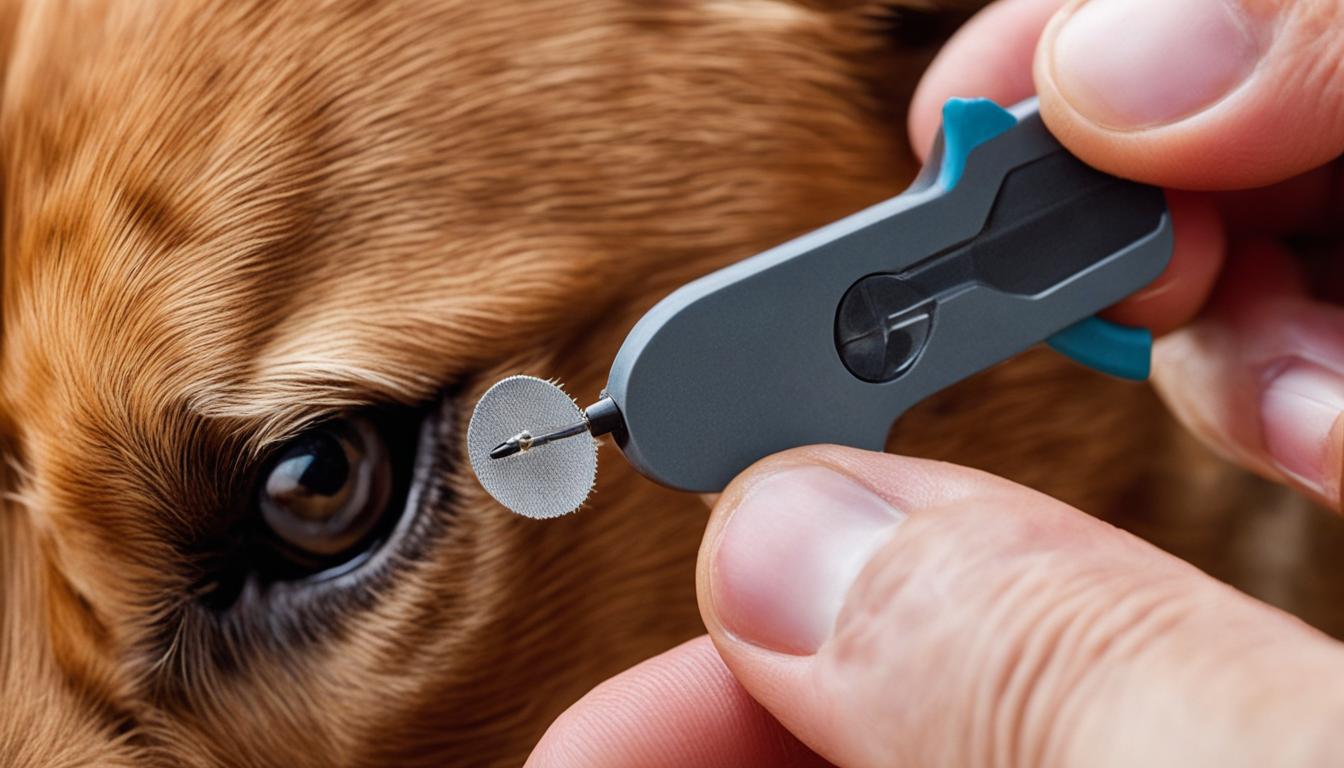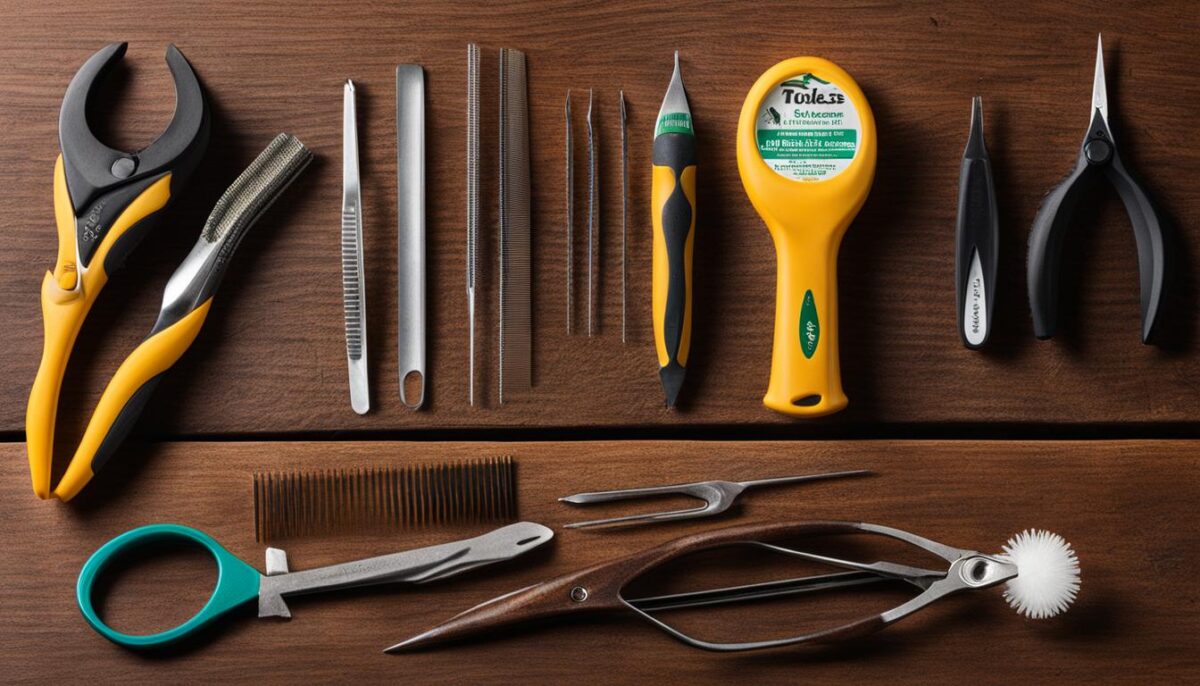If you have a dog, you know how fun it is to play outside together. But there is something outside that is not fun at all – ticks. These little bugs are not only yucky, but they can also make your dog sick. That’s why learning about tick prevention for dogs is so important. Ticks are sneaky, and they can hide in places like woods, tall grass, or even city parks. They look for warm spots on your dog to eat and stay. When they bite, they can pass on diseases, like Lyme disease in dogs.
But don’t worry, taking ticks off your dog isn’t too hard. You just need to know the right way to do it. Using special small tweezers, you can grab the tick close to your dog’s skin and gently pull it straight out. It’s best to stop ticks before they bite, so it’s good to chat with your vet about how to keep ticks from bothering your dog.
Key Takeaways
- Stay safe – learn about tick prevention for dogs.
- Find ticks in warm spots on your dog, like underarms or ears.
- Remove ticks with special tweezers gently and carefully.
- After removing a tick, clean the bite spot and your hands.
- Talk to your vet about the best tick-borne diseases protection.
Understanding the Risks Ticks Pose to Your Dog
Hey there! Did you know that tiny bugs called ticks can be harmful to your furry friend? In this section, we’ll look at why these little critters are a problem and what you can do to help your dog stay healthy.
The Threat of Tick-Borne Diseases
Those little ticks can carry some mean germs that cause big sicknesses in dogs, such as Lyme disease and Rocky Mountain Spotted Fever. These diseases can make your dog feel very sick. It’s why Lyme disease prevention is super important!
Identifying Tick Species and Their Habitats
Ticks can live in many places, like the woods or even your backyard. They love to hide in cozy spots on your dog like the ears and toes. That’s because these are great tick habitats on dogs.
The Importance of Prompt and Proper Tick Removal
Found a tick on your pup? Remove it the right way, and fast! If you do it wrong, parts of the tick can stay in your dog’s skin. That’s no good, because it can lead to tick infestation and tick-borne illnesses. Just remember, when you’re dealing with ticks, wear gloves to keep yourself safe too.
If you need to, tell your vet you found a tick so they can make sure your doggy stays happy and healthy. Now, let’s learn some cool stuff about ticks to help keep your pet safe!
| Disease | Ticks That Carry It | How It Makes Dogs Feel | Prevention Tips |
|---|---|---|---|
| Lyme Disease | Deer Ticks | Tired, sore joints, and fevers | Check your dog for ticks daily |
| Rocky Mountain Spotted Fever | American Dog Tick | Rash, fever, and tiredness | Keep your yard clean of leaves and tall grasses |
| Ehrlichiosis | Brown Dog Tick | Being very tired, not wanting to eat | Talk to your vet about tick meds |
Preventative Measures Against Ticks on Dogs
Keeping your furry friends safe starts with fighting off those little bugs that can make them sick—ticks. Flea and tick prevention isn’t just a once-in-a-while thing; it’s a year-round battle. Even when it gets cold, ticks can still bite. So, it’s extra important to use tick repellent for dogs to keep them away at all times.
Let’s talk about what you can use to make sure ticks don’t get a chance to bite your dog. Some of the best things to consider are special collars or liquids you put on their skin, like Frontline Plus or Seresto collars. Before you choose, have a chat with your vet to see which tick control products are the best pick for your dog.
Remember, when you play outside with your dog, especially in places with lots of trees and tall grass, you’ve got to be super careful. Always look your dog over for ticks when you get back inside. If you find any, take them off right away. It’s better to stop ticks before they can bite your dog. So, let’s make sure to protect our dogs with the right stuff!
Products like Frontline Plus and Seresto collars are well-known for keeping ticks away from dogs. Talk to your vet to find the best option for your pet.
| Product Name | Type | Duration of Effectiveness | Good for Dogs That |
|---|---|---|---|
| Frontline Plus | Skin Treatment | 1 Month | Spend a lot of time outdoors |
| Seresto Collar | Collar | 8 Months | Prefer an easy, long-lasting solution |
So, to keep your dog happy and healthy, and your home tick-free, make sure to use the right products to stop ticks from biting. They are little lifesavers for your pets!
Proper Tools for Safe Tick Removal
When your furry friend has a tick, you need the right gadgets to take it off. This makes sure you don’t hurt them. Let’s find out which tools work the best for safe tick extraction.
Choosing the Right Tweezers or Tick Removal Hook
Special tweezers and hooks are made just for ticks. The Tick Tornado is a cool tool that hooks under the tick without squeezing it. There’s also the Tick Stick, which works in a snap. Both tools are made to take out the whole tick. They make effective tick removal super easy and safe.
Why Household Tweezers May Not Be Ideal
The tweezers you have at home? Well, they might be too big and crush the tick. That’s not good at all. It means they don’t work too well for getting ticks out. Always use tools like the Tick Stick or Tick Tornado for removing those pesky ticks without any trouble.
Remember, picking the right tick removal tools is super important. With gadgets like the Tick Tornado and the Tick Stick, you’ll be a pro at getting those little bugs off without any ouchies for your doggie.
A Step-by-Step Guide to Removing Ticks on Dogs
Getting a tick off your dog doesn’t have to be scary. Here are some simple steps to help you do it right. Remember to be gentle and slow. Your four-legged friend is counting on you!
Initial Preparation and Calming Your Pup
Before you start, you’ll need your tools ready. This includes gloves, a good light, a magnifying glass, the proper tweezers or a tool like Tick Tornado, and some isopropyl alcohol. Don’t forget a container with a lid for the tick and some yummy treats to help keep your dog calm.
It’s important to calm your dog for the tick removal process. Talk softly and give them a few pets or treats. Taking ticks off can be easier if your buddy is relaxed.
Techniques for Efficient Tick Removal
Tick removal steps are easy to follow:
- Put on your gloves to keep germs away.
- Use the extra light and magnifying glass to find the tick.
- Open your tweezers or tick removal tool and gently get close to your dog’s skin, right where the tick is.
- Hold onto the tick without squeezing your dog’s skin.
- Pull straight up, nice and slow. No twisting!
If the tick is by your dog’s eyes or mouth, you might want to ask a vet for help. You don’t want to accidentally hurt these sensitive spots.
Post-Removal Care and Observation
After the tick is out, it’s time for aftercare for tick bites. Here’s what you do:
- Clean the bite spot with water and maybe some soap that’s safe for dogs. Near the eyes? Just water is best.
- Save the tick in your jar with some alcohol. It’s good to have it just in case.
- Give your dog lots of love and maybe an extra treat for being a trooper.
Keep an eye on the spot where the tick was and watch how your dog acts for a few weeks. If they seem sick or the spot looks funny, go see your vet.
Remember, ticks are icky, but with these steps, you can help keep your furry buddy safe and happy!
What Not to Do: Common Myths and Misconceptions
Hey there! When you find a tick on your dog, you want to be super careful about how you take it off. There’s some wrong ways that can really bother your dog or make things worse. Let’s talk about tick removal myths and why they’re not good ideas. It’s all about keeping your pup safe and happy!
Debunking tick removal myths means we want to help you learn the truth. You might hear people say you should burn the tick with a match or cover it with stuff like jelly or nail polish. Nope, don’t do that! Those tricks can actually make the tick hang on tighter, or even make it spit its yucky spit into your dog. Yuck!
Also, remember not to squeeze the tick’s fat body. If you do, it might push bad germs into your dog’s blood. And don’t try to wiggle or twist the tick out. If you do, the tick’s head might stay stuck in your dog, and that’s no good. The head being left behind can cause infection.
Always use the right tools and be gentle. You want all of the tick out, head and all, so it can’t bug your dog anymore.
| Myth About Tick Removal | Truth About Tick Removal |
|---|---|
| Burn the tick with a match | Heat can make the tick hold on tighter |
| Put jelly or nail polish on the tick | These don’t make the tick let go, and can hurt your pup |
| Squeeze the tick’s body | Squeezing can shoot germs into your dog |
| Wiggle or twist the tick out | This can leave the head in your dog’s skin |
To avoid tick bite misinformation, talk to a vet or use the right tools like fine-tipped tweezers or a tick removal hook. Keep everything nice and clean, and give your pup a little treat for being such a good sport. If you’re ever unsure, just ask your vet what to do!
Conclusion
After you have carefully removed a tick from your furry friend, it’s important to keep a close eye on them. Look at the spot where the tick was. Is it red? Does it look swollen? Or maybe your dog is acting a little bit different than usual? If you notice anything like this, you should let your vet know right away. They’re there to help keep your pup feeling their best.
Post-Tick Removal: What to Watch For
Don’t throw away the tick after you take it off. Instead, put it in a small container with a piece of wet paper towel. Keep it just in case your dog starts feeling sick. That tick can tell a vet a lot about what could be wrong. This is part of monitoring after tick removal. So remember, keep that tick and keep an eye on your dog!
Importance of Regular Vet Check-Ups and Ticks
Regular visits to the vet are very important for your dog. This is where you can talk about tick follow-up care and how to stop ticks from bothering your dog again. Your vet knows a lot about veterinary guidance for ticks and can help you take the best care of your dog. So, make sure you go for check-ups and chat about ways to keep those ticks away!
FAQ
How can I prevent ticks on my dog?
Tick prevention for dogs involves using veterinarian-recommended products such as tick repellent collars, topical treatments like Frontline Plus, or oral medications. It’s also wise to keep your yard trimmed and avoid tall grasses during walks.
What diseases can ticks transmit to my dog?
Ticks can carry a variety of tick-borne diseases, including Lyme disease, Rocky Mountain Spotted Fever, and Ehrlichiosis. These illnesses can cause serious health issues in dogs, so prevention and prompt removal are crucial.
How do I safely remove a tick from my dog?
Use fine-tipped tweezers or a tick removal tool like the Tick Tornado to grasp the tick as close to your dog’s skin as possible. Gently pull straight up with steady pressure. Avoid twisting or squeezing the tick. After removal, clean the area with soap and water or an antiseptic.
Can ticks live in both rural and urban areas?
Yes, ticks inhabit a wide range of environments, from wooded and grassy rural areas to some urban parks and yards. They can thrive anywhere there are animals to feed on.
What should I do with the tick after I remove it from my dog?
Place the removed tick in a jar with a bit of isopropyl alcohol and close it with a lid. This is for identification purposes if your dog shows any signs of illness. Contact your vet to inquire whether they need the tick for testing or if you should dispose of it.
Why are household tweezers not recommended for tick removal?
Household tweezers might be too thick to get close enough to your dog’s skin and could end up squeezing the tick’s body, potentially increasing the risk of infection by releasing the tick’s saliva or blood into the bite area.
What are the common myths about tick removal?
Common myths include using petroleum jelly, nail polish, or heat to make the tick detach itself. These methods are ineffective and can cause the tick to discharge more harmful bacteria into the bloodstream.
How can I tell if a tick has infected my dog?
After a tick bite, monitor your dog for symptoms such as fever, loss of appetite, swollen lymph nodes, or lameness. If you notice any unusual behavior or signs of illness, contact your veterinarian immediately.
Is it necessary to take my dog to the vet after removing a tick?
It’s not always necessary to visit the vet after each tick removal. However, if you are concerned about proper removal, potential tick-borne diseases, or if your dog shows any sign of illness, it’s important to consult with your veterinarian for guidance and possible screening for infections.
Can ticks bite all year round?
Yes, ticks can bite throughout the year, though they are most active during the warmer months from April to September. It’s important to provide year-round protection for your dog against tick bites and the diseases they can carry.


